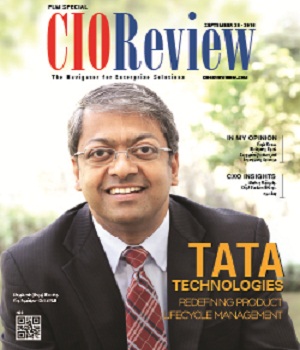
A virtual path to collaboration, innovation and agility: It's all about the end-user
Martin Schneider, CIO, VF Corporation | Thursday, 20 October 2016, 10:15 IST
 What does technology-enabled collaboration look like when it’s seamless? Most companies—especially those lacking virtualization technologies— likely have no idea.
What does technology-enabled collaboration look like when it’s seamless? Most companies—especially those lacking virtualization technologies— likely have no idea.
Here’s what IT doesn’t look like: You’re starting an online meeting, but you can’t connect into the bridge. You boot up your computer to take notes, but your machine is frozen, forcing you to revert back to pen and paper. Your video conference screens freeze mid-call. Callers accidentally get dropped from the line. This is the technology world most companies still reside in. But it doesn’t have to be.
Here’s what it can (and should) look like: Every single computer throughout the company has desktop video, which functions individually, for groups and externally. All desktops can be shared desktops virtually by individuals, groups or external partners. Data is cloud-based. You can access the same information from any device, whether that’s a phone, an iPad, desktop, laptop or home computer. Colleagues in Buenos Aires, Singapore, London and Greensboro can view and update shared information in real time.
Shifting the paradigm
When VF, the global leader in branded apparel and footwear, was reaching the end of life for our Windows XP operating system, we had a decision to make. Three criteria set the backdrop. First, the solution needed to be cost effective. Second, it needed to provide our 60,000-strong workforce, dispersed across 70 countries, with a robust platform by which to collaborate and innovate. Finally, it needed to enable agility throughout our organization, allowing employees to work wherever they choose and with the devices
they prefer.
As CIOs, we always weigh technology-related decisions driven by some central questions.A frequent one is:How can we take money out of the system? How can we support the needs of the business? What are the risks to a certain approach? Yet truly advancing innovation and agility demands a paradigm shift. It’s all about the end-user. This time, we asked different questions: How can we enable our internal business partners to be most effective? How can we change their jobs for the good of the business?
Of course, cost savings are still critically important, but it was clear that we had to spend some money, so we set out to do so in a way that boosted the productivity of our environment, and it certainly has. Our virtualization platform has fueled creativity, product innovation, and employee satisfaction—and the bottom line.
What we did
In April 2014, we leapfrogged from a legacy world with a patchwork of operating systems to the Microsoft 365 toolset, including virtual meeting rooms, Skype for Business, SharePoint, Outlook, Office 365 and Azure cloud capabilities.
It didn’t happen in the blink of an eye. Before going live, we had to have someone manually update every single computer in our company — 18,000 laptops and desktops worldwide. However, going forwardall future upgrades and software would be pushed through via mobile updates. It’s a no-touch environment, i.e. no physical installs from the IT group.
How it’s changed procurement
As the number one producer of denim in the world, we procure over 600 million yards of fabric (not just denim) each year across all of our brands. That’s roughly enough to wrap around the earth three times. Consider momentarily the sheer number of contracts with suppliers required to source the raw materials.
Our new platform has shortened the time to contract completion significantly, because of the ability of our team to collaboratively markup of documents internally and externally. More importantly, procurement can act as one team, instead of outposts for different brands, since they can leverage information for demand planning and forecasting in real time, regardless of location.With this toolset, we have learned from each other and have become a community driven by best practices.
For example, VF can efficiently conduct sourcing events, whether it is for leather, shoe boxes or in-store fixtures, across brands and regions. We now act as a community rather than individual and isolated buyers. Technology allows us to maximize global scale, leverage expertise, more efficiently analyze data and make better decisions, which allows us to reduce costs and achieve shorter contract timing internally. The productivity increase is breathtaking.
Meetings, too, have gotten shorter and more effective. In the past, we’d send version after version of spreadsheets. Now, we have a big screen in each location, with everyone viewing the same information at the same time. We can make changes on the spot and see the implications immediately. In many cases, what used to take an hour now takes 15 minutes. Without the need to printendless spreadsheets, we also conserve precious resources, helping us improve sustainability. Finally, when virtual meetings between distant locations are so effective, there is less need to travel. And when travel is necessary, the prior collaboration makes the in-person visit that much more focused and effective.
Implications for your organization
I often hear from CIOs at other organizations that they are using virtualization technologies, but only in certain locations, such as at headquarters. Wehave every location and every employee connected to the same platform. Even the 45,000 employees who don’t sit at computers but who work at our distribution centers and on our factory floors have access to the same information on their own devices.
As our reliance on technology grows, it becomes even more vital to the success of the business. This is true at every organization, yet too many CIOs are asking the wrong questions. Do your technology support internal customers to easily share best practices, access information, make decisions, and collaborate internally and externally? If not, it’s time to look more broadly at how you can enable internal customers to do their jobs with maximum effectiveness.
Our virtualization platform has laid a solid foundation for us to share best practices, collaborate, and innovate as one organization—one VF. From an IT perspective, we looked at the benefit to the end user in a different way, and we have never looked back.
CIO Viewpoint
End to End Supply Chain Planning is the Need of...
By Abel Correa, CIO , Arvind Lifestyle Brands
Managing Insurance Portfolio through a Smartphone
By Mehmood Mansoori, Member of Executive Management - IT Innovation & CEM, HDFC ERGO General Insurance Company
Optimize routes with Central level integration
By Tarun Anand, GM - IT, Mother Dairy Fruit & Vegetable
CXO Insights
The Monumental Shift in Traditional PLM Centric...
By Dr. Chandan Chowdhury, Managing Director, Dassault Systemes India
Benchmarking Report Administering organizations...
By Nagi Kasinadhuni, GM, Communications, APAC, Dimensions Data India
Embracing Cloud-Communications for a...







